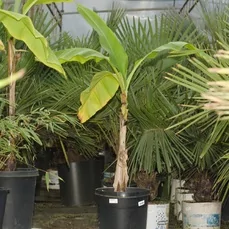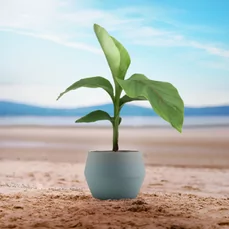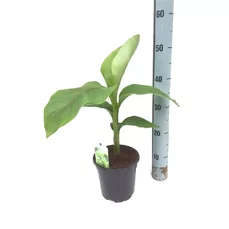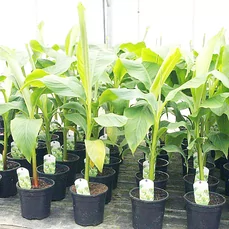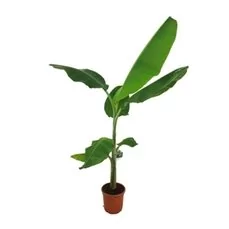Musa basjoo
The Musa basjoo is perfectly suited for the Dutch garden!
Yes indeed! The Musa basjoo is completely winter hardy, but that only applies to the trunk. The roots should remain below ground, because there it hardly freezes. Above ground the trunk remains standing which can withstand the cold. The leaves should be removed before the frost period. Then in spring new larger leaves will appear very quickly!
Frequently asked questions, FAQ
.Is the Musa basjoo hardy?
The Musa basjoo can tolerate cold up to a wind chill (so depending on how much wind there is) of 18 degrees below zero. Below that it should be protected.
How to care for a Musa basjoo
.You can find everything about caring for the Musa basjoo in our extended encyclopedia article
How to Protect a Musa basjoo from Frost/Wintering
When the cold gets below -18 degrees, protection is necessary for the survival of a Musa basjoo. You do this by wrapping fleece (a good breathable thin cloth) around the leaf crown to block the wind. If the Musa basjoo is in full ground, then no protection for the root ball is needed for this. But if it is in an uninsulated pot, then the root ball also needs to be protected. You can do this by wrapping bubble wrap (or other insulating material) around the pot. So that the wind no longer has any influence through the rim of the pot.
When to water the Musa basjoo?
When the Musa basjoo is outside it needs very little water during the winters, almost none. But during the hot days of summer it should be watered every day, sometimes as much as 2x on the very hottest days. In between, it can be once every 2-4 days, depending on the temperature. You can feel this in the soil. If the soil is fairly moist, the banana plant still has enough water.
What kind of soil does the Musa basjoo want?
A Musa basjoo likes good nutrient soil. For example, you can pamper the root ball with a bag of Florentus Mediterranean Nutrient Soil, specially developed for Mediterranean plants such as the Musa basjoo.
How to prune/prune a Musa basjoo?
For a Musa basjoo, it is a natural thing for leaves to become dry and die. You can simply cut these off close to the stem. The banana plant is not affected by this. It is also often recommended to cut off the leaves before the winter so that the energy no longer goes there to grow, because the new year there will be new leaves again.
When to put the Musa basjoo inside?
The Musa basjoo can withstand the hot sun well, so in summer it doesn't need to go inside. It can also withstand rain well, so during fall and spring and rainy days of summer, it doesn't need to go inside either. But, at -18 freezing temperatures (so really by exception in the Netherlands) he gets a hard time. Then he needs to be protected, or taken to a warmer place.
How to take cuttings / propagate a Musa basjoo
.To propagate the Musa basjoo, please refer to our extended encyclopedia article that explains everything.
Why does a Musa basjoo get yellow leaves?
It could be that the Musa basjoo does not get enough water during the growing season, but it is also a natural thing for leaves to become barren. Some leaves have simply reached their age and then die off. The leaves can be removed with scissors, or by hand.
Are Musa basjoos toxic to cats/dogs ?
.The Musa basjoo is non-toxic, so it is fine to be placed in an environment with cats/dogs.
Where to buy a Musa basjoo?
We have a very simple answer to this question. Teeninga Palms is a specialist in hardy Mediterranean plants and trees, offering them at the lowest price and highest quality, so the choice is easy!
It grows fairly quickly and can grow up to 400cm tall in the Netherlands, with leaves as long as 200cm. In a warm summer, a lotus flower can also develop from which small bananas can grow. Unfortunately, in almost all cases they are too small to eat, but it still really gives the feeling of the tropics in our Dutch backyard.
Would you like to buy a hardy banana plant? Then we recommend the Musa basjoo, it is a real winner!
The Musa basjoo is a fast grower but stops growing below 14C.
We therefore advise you to keep cuttings of 35 cm inside first until the end of April/May, so they can grow well, and then plant them out. Then you will have a nice big banana plant in the summer months.
Winter protection:
The roots of the Musa basjoo are very hardy, sometimes they are even said to withstand minus 20 degrees (in the open ground).
We do recommend protecting the Musa basjoo though!
You can do this by wrapping the trunk in the colder months.
To protect the Musa basjoo during the winter:
1. First, remove all the leaves from the Musa basjoo.
2. You cut the trunk to the desired height (1 meter high).
3. Chicken wire around the trunk and fill it with hay.
4. Old leaves over the ground near the Musa basjoo.
5. Then wrap it with fleece or burlap.
If the trunk is protected well enough during the winter months, the Musa basjoo will continue to grow from there!
If the trunk has not been protected or has not been protected well, the Musa basjoo will turn into a goo-like substance. Note: Remove the rotten parts and then the Musa basjoo will reappear from the ground later!
The Musa basjoo is hardy only in the open ground. In a pot, it should overwinter frost-free.


